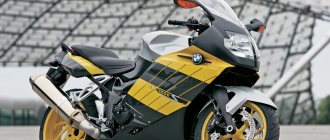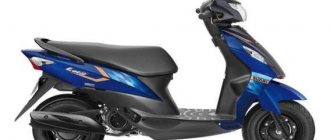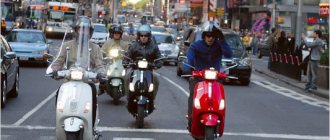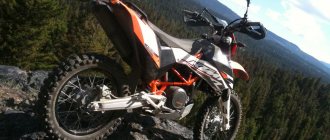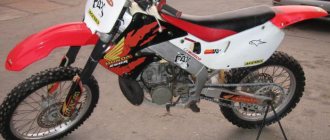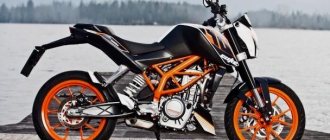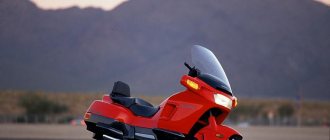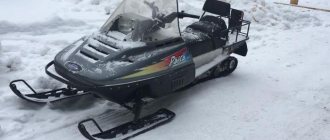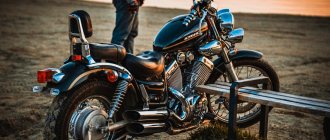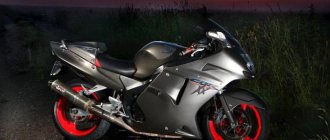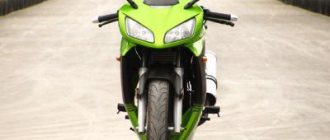400 cc Chinese enduros occupy a special place in the motor market. Goods produced in the Middle Kingdom no longer seem throwaway, do not hurt the eyes with their monstrous design, and do not crumble into dust during use. Motorcycles, of course, are technically inferior to their Western counterparts, but their competitiveness is gradually increasing. And the price is comparable to the cost of Japanese secondary goods.
Stels 400 Enduro is a striking example of modern motorcycle construction in China. It has a completely modern appearance, technical characteristics and dynamics. If you are thinking about purchasing this equipment, our article, which talks about all its features, will be very useful to you. A review of owner reviews will give you an idea of what to expect from this motorcycle during operation.
001_MOTO_0810_024
S-MOTO 400: enduro, 2010, 387 cm³, 30 hp, 145 kg (dry), 150,000 rub.
S-MOTO 400: enduro, 2010, 387 cm³, 30 hp, 145 kg (dry), 150,000 rub.
The niche of “four hundred” in Russia has long been firmly occupied by Japanese second-hand stores: in capable hands the devices last a long time. But there are almost no new cars, because many brands have left this sector of the market. Ordinary motorcycle manufacturers from the Middle Kingdom, having perfected their 150-200 cm³ “air vents”, are in no hurry to dive headlong into the next class, which requires a different level of technology. It is all the more interesting to evaluate a new product on the Russian market, which will play in the “adult” league.
They say that the impression of the first sight largely shapes subsequent relationships. The sweeping contours of the front fender and complex-shaped headlight shield, outlined with bright blue stickers, immediately attract attention. And the dense layout inside the matte black frame hints that the filling here is serious. At the same time, 400 cubes (more precisely, 387), unusual for the Chinese motorcycle industry, were able to fit into a fairly compact power unit, primarily thanks to the short-stroke cylinder-piston group. The engine design is quite modern: 4 strokes, 4 valves, liquid cooling. Works in tandem with a 6-speed gearbox. We couldn't resist the temptation to see what was inside, so we disassembled the power unit. There was a T-shaped piston in a very low cylinder (see manufacturer's data) - the first pleasant surprise. The second is the minimum gaps between the crankshaft and balancer shaft, which also shows how much the designers cared about compactness. The valves are controlled by two rocker arms with roller tappets, and the clearance is adjusted with screws. The camshaft is driven by a chain, this is not new, but the completely plastic (except for the spring) tensioner was surprising. Just like the plastic thermostat in the “head”. In general, the motor turned out to be compact. And it looks like it’s original (I don’t know if that’s good or bad).
Reviews from Stels 400 Enduro owners
- The bike is so-so overall, but for its price you can’t buy a Japanese one, even a damaged one, so there was no question of choice. It doesn’t fall apart on the go, doesn’t lose spare parts, but it does require attention periodically for small things. The standard tires are rubbish, the headlight shines like a Chinese lantern. The engine is torquey, the transmission is clear, the brakes are normal. Sergey, Syktyvkar, Stels 400 Enduro '2011
- There are no complaints about the quality of the motorcycle itself; I can’t say anything about the build quality, since I bought the bike second-hand with a mileage of 12,000 km. It drives briskly, tosses and turns easily, and rushes off-road like a tank. There were no breakdowns (the mileage is now 26,000 km and growing). Among the design flaws is the short front fender, the engine gets covered in mud, and I would like a larger gas tank, especially since there is no fuel level sensor. Dmitry, Orel, Stels 400 Enduro '2013
- An excellent motorcycle for the money, I don’t understand why it was discontinued. It's good that there are spare parts in stores. Although they don’t seem to be needed, the moped doesn’t break down, and you can pick up consumables from other Chinese if you want. It eats and rushes vigorously, both in the city and in the countryside – it’s a pleasure. Marat, Pushkino, Stels 400 Enduro '2014
004_MOTO_0810_024
Having disassembled the engine, we were amazed at what a step forward the Chinese motor industry had made - both in design and technology.
Having disassembled the engine, we were amazed at what a step forward the Chinese motor industry had made - both in design and technology.
The steel space frame is powder coated black. However, everything else was painted in Henry Ford’s favorite color, except for the aluminum parts (pendulum, muffler, trunk, steering wheel, license plate bracket and rims). And it is proposed to expand the color range through self-adhesive ornaments.
As it should be on “correct” enduros, the electrical circuit of the ignition system includes sensors for side support and gear engagement. The ignition switch has a steering lock position, the tank cap is locked and there is a helmet lock on the side of the saddle - just like on the Japanese.
On the ascetic-looking dashboard there is a dial mechanical speedometer and a coolant temperature indicator. I think too much attention has been paid to the latter - it would be better if they installed a tachometer here. The latter is sorely lacking, especially considering the six-speed gearbox. There’s nothing to say about the controls, except that I’ll note the two-cable throttle handle - this is the first time I’ve noticed this on Chinese enduros (on others it’s par for the course).
There is a plug in place of the kick, which is a minus for enduro (although the kick can be installed as an option). However, you will find this on many modern devices. There were no problems with the electric start, and the engine responded quite loudly at idle.
It is not easy for a driver of shorter than average height to climb onto a motorcycle: the saddle height is 900 mm. This is the price for long-travel suspensions (280 mm) and ground clearance (300 mm). The rear suspension is progressive, with a linkage system. By the way, a revision of the “rocking chair” design showed: it was made in accordance with the canons - on needle bearings, with cuffs. The suspensions are quite modern: an “inverted” fork with compression and rebound adjustments and a monoshock absorber (gas-filled, but without a remote reservoir) with compression and spring preload adjustment (with a nut).
The brakes front and rear are two-piston, and the pads are interchangeable. No shortage is expected: the same type is used on Honda and KTM off-road vehicles. But the metal tube in the brake line of the front brake surprised me. Did you save money on a reinforced hose or were there deeper considerations? One way or another, there are no complaints about the brakes, as well as reasons for admiration.
008_MOTO_0810_024
| ■ The double-cable throttle is a small plus for a “real enduro.”■ The complex-shaped headlight contains a regular 35/35W Philips Duplo lamp; it was not possible to evaluate its performance in white night conditions.■ The closed steel frame and motor are painted black. The engine is very compact, but it is a pity that there is no kick starter. Very low cylinder. Access to the candle is easy. There is an electric fan.■ The saddle is one and a half, due to this the trunk is shifted forward. There is no space for tools under the saddle. |
The ambitions of the device in the niche of real enduro (which the “four hundred” from the domestic Japanese market have always been famous for) are declared by full-profile Kingstire tires (21 inches in the front, 18 in the rear). Their universal tread is made with a clear bias towards off-road, and its depth is decent: 12 mm on the rear wheel. The chain here is also endurable - the common 520, and with seals, which is atypical for the Chinese motorcycle industry. The one and a half hard saddle brings the motorcycle closer to hard enduro: sitting on this, you remember the joke about Lieutenant Rzhevsky and the frying pan. However, for the passenger there are quite comfortable handles on the sides of the trunk. But he will have to accept the fact that half of the sirloin will end up on the trunk. But on solo trips you can place a heavy load in the case above the rear wheel axle.
On the way from the metropolis to off-road spaces, I estimated the maximum speed: it was about 120 km/h (with a passenger). Perhaps after running in the device will run faster. But when landing directly and accelerating above 110 km/h, it starts to sail, and the pleasure of driving disappears. However, for light enduro this is rather the norm.
The dynamics in the city seemed sluggish for the declared 30 “horses”. This may be due to the lack of constant vacuum from the accelerator pump in the carburetor. However, it is expected that a Dell'Orto spool valve with a pump will be installed; such a sample was demonstrated in the showroom.
I was very pleased with the absence of vibrations throughout the entire range of engine operation. The gears are long, and at first it seemed that there were “no number of them” (there is not enough tachometer during spin-up). The sixth one was turned on after 90–100 km/h, it was used to save fuel during long-range driving. It is significant that the “neutral” was easily caught, even in static conditions, something that the gearboxes of other “more branded” motorcycles cannot boast of.
On broken gravel roads I finally appreciated the performance of the suspensions. There is a clear breakthrough by Chinese manufacturers - for a long time it was suspensions that were the weak point of off-road vehicles. On the coastal rocks of the Kronstadt forts we were able to fully experience the high ground clearance. And the fact that the first gear was “too high” meant I had to play with the clutch. The sand confirmed the correctness of the weight distribution, although the test on this surface cannot be fully described as it had rained the day before.
Price
The cost of a Stels ATV 400 Hunter ATV with zero mileage currently varies in the range from 155 thousand rubles to 180 thousand Russian rubles. The price varies depending on the model configuration and its year of production.
A cheaper and more accessible option is to purchase an all-terrain vehicle with accumulated mileage. The price tag for such a car depends on the year of manufacture, technical condition, and, of course, mileage. The average cost now ranges from 80 thousand rubles to 120 thousand Russian rubles.
015_MOTO_0810_024
A paper air filter provides effective cleaning, but, unlike a serviceable foam filter, it is an extra item on the list of consumables.
A paper air filter provides effective cleaning, but, unlike a serviceable foam filter, it is an extra item on the list of consumables.
In conclusion, let’s talk about the identified shortcomings. There was no place for a tool or a small shmurdyak - the same “Japanese” have pencil cases, albeit small ones. In a tank designed for trips of up to 150 km, the level of gasoline is not visible. Short front fender. Maybe this is not so bad, but the radiator is not equipped with protection against dirt, and in the area where dirt escapes from under the front wheel there is also a sound signal. And at the end of the test it turned out that the plastic chain protection shield was wrapped and rubbed through.
In general, the device is certainly worthy and is not much different from the Japanese technology beloved by many. The only question that remains open is minor tuning such as engine protection or windshields, durability and availability of spare parts.
Similar models
Honda XR 400. A long-discontinued model that still enjoys well-deserved popularity. Simple, reliable and durable, it has, perhaps, only one serious drawback - the advanced age of most specimens.
Suzuki DR-Z400. Produced in “enduro” (DR-Z400) and “motard” (DR-400SM) versions, this bike was once intended to compete with the aforementioned Honda. In terms of technical characteristics, it is almost no different from it.
Yamaha WR 400. Perhaps the most “off-road” bike of all those listed here. It also has its weaknesses, but in the hands of an experienced motorcyclist it is capable of very impressive feats.
007_MOTO_0810_024
The test was conducted in St. Petersburg and its suburbs.
The mileage was 130 km: through the city, the highway, the grader road, the sandy beach of the Gulf of Finland and the stones of the Kronstadt forts. The test was conducted in St. Petersburg and its suburbs.
The mileage was 130 km: through the city, the highway, the grader road, the sandy beach of the Gulf of Finland and the stones of the Kronstadt forts. Technical characteristics of C-MOTO 400 (manufacturer's data)
| COMMON DATA | |
| Model year | 2010 |
| Dry weight, kg | 145 |
| Length/base, mm | 2155/1400 |
| Seat height, mm | 900 |
| Steering wheel width, mm | 820 |
| Ground clearance, mm | 300 |
| Gas tank volume, l | 9 |
| Load capacity, kg | 150 |
| Maximum speed (actual), km/h | 120 |
| ENGINE | |
| Type | 1.4T |
| timing belt | ONS, 4 valves per cylinder |
| Working volume, cm³ | 387 |
| Cylinder diameter × piston stroke, mm | 91×59,5 |
| Compression ratio | n.d. |
| Max. power, hp at rpm | 30/7500 |
| Max. torque, Nm at rpm | n.d. |
| Supply system | constant vacuum carburetor |
| Cooling system | liquid |
| Starting system | electric starter |
| TRANSMISSION | |
| Clutch | multi-disc, oil bath |
| Transmission | 6-speed |
| main gear | chain |
| CHASSIS | |
| Frame | steel spatial |
| Front suspension | inverted telescopic fork with hydraulic compression and rebound adjustment, Ø 41 mm |
| Rear suspension | Monoshock absorber with progressive characteristics, adjustable spring preload and compression hydraulics |
| Brake system | separate, hydraulic |
| Front brake | disc Ø 260 mm, 2-piston caliper |
| Rear brake | disc Ø 235 mm, 2-piston caliper |
| Front tire | 3,00–21 |
| Rear tire | 4,60–18 |
The equipment for the test was provided by St. Petersburg.
We thank Dmitry Karasev for his help in conducting the test.
In the adult league - premier test C-MOTO 400
Pros and cons of Stels 400 Enduro
Advantages
- Very attractive combination of price and technical characteristics
- General reliability and ease of maintenance
- Availability of spare parts from a number of dealers, and at affordable prices
- Economy and fuel consumption within 4l/100 km (when driving on asphalt; off-road driving causes the gas tank to empty very quickly)
- Simplicity of design, thanks to which you can service and repair the Stealth 400 Enduro in the garage on your own using an inexpensive set of tools
- Quite modest weight for a 400 cc enduro
- Grippy disc brakes with 2-piston calipers on both wheels
- High-torque motor that easily pulls the motorcycle out of the mud
- Sufficiently energy-intensive suspensions, with an inverted fork installed at the front
- Flexible plastic that can survive a fall
Flaws
- Small gas tank with a volume of only 9 liters
- Weak light from the headlight (partially corrected by replacing the light bulb in the headlight with a more powerful one)
- Hard and uncomfortable seat
- The bike is too small for two people
- There are minor assembly defects such as loose nuts and carelessly insulated wires (correctable on your own)
